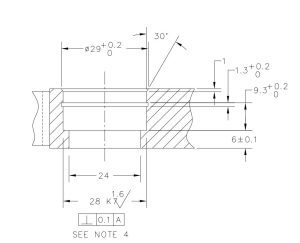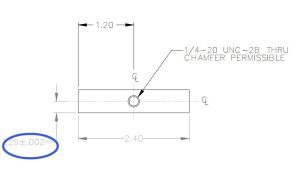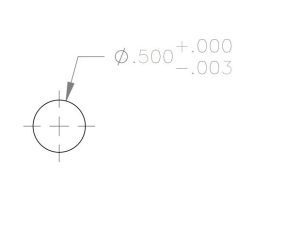How To Select The Right CNC Machining Tolerances?
Introduction
How do you select suitable CNC machining tolerances? It can be a daunting task, but some key things must be kept in mind. We’ll outline what to consider when choosing your machining tolerances and walk you through some of the most common tolerance levels.
By comprehending the pros and cons of both levels, you can select the tolerance that is best suited for your needs. Let’s get started!

Keypoints When Designing The Right Tolerances??
When do you need Tight Requirements?
Most products will have a combination of tight and loose tolerances. Understanding when you need tight tolerances is essential to avoid costly mistakes. In general, you will need tight tolerances when:
- The fit between two parts is critical for the function of the product.
- The aesthetic of the product is important.
- The manufacturing process is unable to achieve consistent results at a lower tolerance level.
On the other hand, loose tolerances are often used when:
- The fit between the two parts is not critical.
- There is some leeway in the aesthetic of the product.
- The manufacturing process is able to achieve consistent results at a lower tolerance level.
So, you can see that the decision to use tight or loose tolerances depends on various factors. When in doubt, it’s always best to err on the side of caution and go with a tighter tolerance.
High Costs for Tight Requirements
One of the critical things to bear in mind is that tight tolerances come at a cost. The faster the patience, the more expensive the machining process will be.
This is because achieving tighter tolerances requires more precise and expensive machining equipment.
In addition, the manufacturing process will take longer since the margin for error is smaller.
It is essential to factor in these costs when deciding on your tolerances. If you don’t need tight tolerances, there is no sense in spending the extra money. However, if tight tolerances are critical for your product, you must factor in the increased cost.
Choice of Manufacturing Methods
The manufacturing method you choose will also have an impact on the tolerances you can achieve. Some techniques, such as 3D printing, can achieve very tight tolerances.
Some methods, like CNC machining, have more relaxed standards. This is because different manufacturing processes have other capabilities. With CNC machining, for example, the tolerances will depend on the type of machine used as well as the skill of the operator.
Your choice of manufacturing method will therefore impact the patience you can achieve. Though, this is important to note that even the most precise methods will have some margin for error.
Tolerances Depend on the Material
The type of material you are machining will also impact the tolerances you can achieve. Some materials, such as aluminum, are more accessible to the machine to tight tolerances.
Others, such as stainless steel, are more difficult and require looser tolerances. For this reason, make sure to factor in the type of material when deciding on your patience. Any experienced machinist can tell you what the capabilities are for different materials.
Inspection
No matter what tolerances you choose, you should inspect and test your parts during and after manufacturing. This will ensure that your details meet the required patience and are free of defects.
Various inspection methods are available, such as visual inspection, dimensional inspection, and testing. The way you choose will depend on the type of product you are manufacturing.
Common Types of Tolerances In CNC Machining
1. Standard Tolerances
The most common type of tolerance is standard tolerance. Standard tolerance specifies a number followed by a letter.
The number represents the maximum deviation from the nominal value, while the letter represents the type of deviation. For example, a tolerance of +/- 0.2mm would be written as 0.2mm-ST. This means that the actual value can be up to 0.2mm away from the nominal value in either direction.
2. Bilateral Tolerances
Bilateral tolerances are similar to standard tolerances, except that they allow for a more significant deviation from the nominal value.
For example, a tolerance of +/- 1mm would be written as 1mm-BT. This implies that the real value could be 0.1mm to 1mm from the nominal value, either way. Bilateral tolerances are often used when the fit between two parts is not critical.

3. Geometric Dimensioning And Tolerancing
GD&T is a system of symbols and rules used to specify a part’s tolerances. The GD&T symbols are used to identify the type, size, and orientation of tolerances.
GD&T is often used when manufacturing parts with complex shapes. Most CNC machinists are familiar with GD&T and can use it to produce parts with tight tolerances.
4. Unilateral Tolerances
Unilateral tolerances are the least permissive type of tolerance. Only one direction of deviation is permitted from the nominal value.
As an example, a tolerance of +/- 0.1mm would be indicated as 0.1mm-UT. The part is rejected whenever the value deviates from the little value by more than 0.1mm. You will often see unilateral tolerances used in the aerospace and medical industries.

5. Limit Tolerances
Do not confuse often limit tolerances with unilateral tolerances. Limit tolerances are a combination of bilateral and unilateral tolerances. Limit tolerances always have two numbers, a lower limit and an upper limit.
The actual value must be between these two limits to be accepted. For example, a tolerance of 0.2mm to 0.4mm would be written as 0.2-0.4mm-LT. Some people consider limit tolerances to be the most permissive type of tolerance.
Conclusion
Selecting the right CNC machining tolerances can be a daunting task. With all of the different factors to consider, how do you know which patience is best for your part? The team at WorthyHardware has put together this guide to help walk you through the process of selecting the proper tolerances for your next project.
By following these simple steps, you can rest assured that your parts will meet or exceed your expectations. Have any questions about choosing CNC machine tolerances? Contact us today, and we’ll be happy to help.

